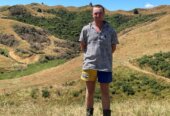
Janine Krippner
The day this comes out I will be in the field with PhD student Amilea Sork, looking at huge rocks that were violently thrown out of the Ngāuruhoe crater during the 1950s and 1970s eruptions.
These are called ballistic ejecta, or blocks if they were solid when they erupted, bombs if they were molten. During the eruptions this area would have felt more like a war zone than a serene national park. Amilea and I affectionately refer to one of these areas as the ‘Hulk Smash’ zone because it looks like a battle of giants took place. It is baffling how unrealistic eruptions in movies often are when they are dramatic and scary enough in real life.
Seeing these large rocks, many several metres in diameter that landed over a kilometre away, I have imagery playing through my mind of what this could have looked like. These hot rocks are flung upwards out of the vent then change track back towards the Earth, some of them still molten and changing shape as they go, then they impact the flanks after reaching speeds of over 100 meters a second. Some shatter on impact, others bounce and rolled at incredible speeds, likely shaking the ground and kicking up volcanic ash around them as they go. Total chaos. A person would feel incredibly small and fragile.
Countless times I have played these scenarios through my mind, going over what I would do. If I were lucky, I would have a chance to cover my head with what ever I could, if I were even luckier, I would get as many barriers as possible between me and the volcano.
Field work helps us to better understand what this scenario might look like at Ngāuruhoe the next time it erupts, especially along the popular Tongariro Alpine crossing, and each project like this adds to our global understanding of eruptions. Sharing information and learning from each other is critical in our small field of a few thousand volcanologists around the world. Our own Canterbury volcanology group has done important work firing a cannon at materials to analyse what sort of shelters can hold up to these forces.
One scary aspect is that this is a process that can occur during phreatic eruptions that are driven by steam, not magma, and therefore they do not have the same warning signs that an eruption might be coming. Several eruptions like this have injured or killed visitors, like Ontake in Japan in 2014 where over 60 hikers lost their lives.
It is important to know what this hazard is and stay out of any exclusion zones. When Ruapehu is on an elevated alert level the summit area is a no-go zone partly because of these deadly projectiles, not to prevent people from seeing the show.
Many times, I have heard the idea of simply watch it coming to see where it will land, but what to you do when there are dozens in the air? The best way to survive is to have a warning and not be there in the first place.









